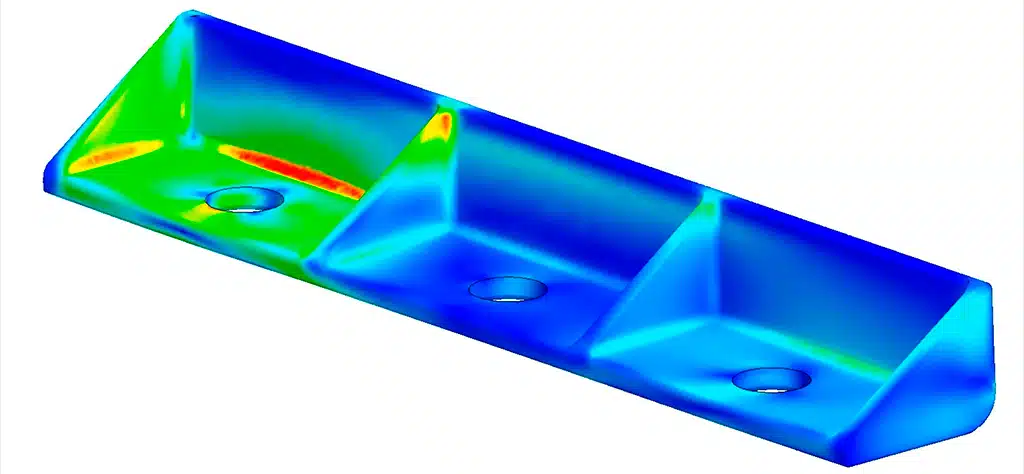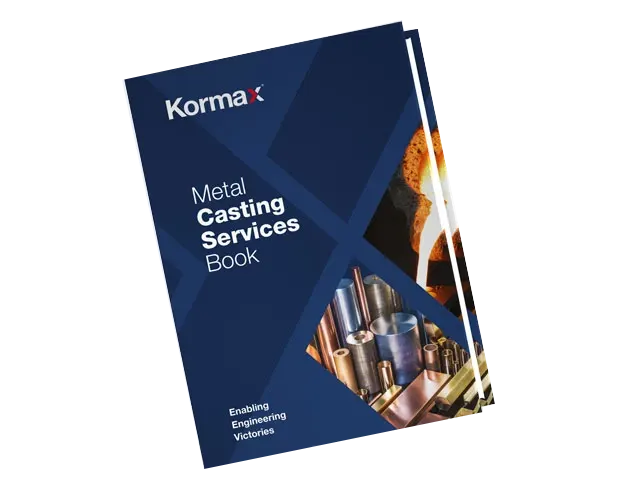Ensuring cast component quality is crucial for performance, reliability, safety, cost efficiency, regulatory compliance, process optimization, and importantly customer satisfaction and brand reputation. By prioritizing quality throughout the casting process, companies can produce superior castings that meet the highest standards and deliver exceptional products to their customers. However, achieving world-class quality castings is not a simple task; it requires meticulous attention to detail, comprehensive design considerations, and accurate simulations.
In this blog we will look at the significance of experience in understanding the casting processes and how their attributes and limitations should be considered in the part design process. We will also discuss the role simulation technology plays in ensuring quality.
The significance of experience and design in ensuring a quality cast product from the start.
Understanding manufacturing processes and thus designing with manufacturability in mind during the early stages of development will result in the consistent delivery of reliable components.
Understanding the casting process.
Casting encompasses various techniques such as sand casting, investment (lost wax) casting, and die casting. Understanding the strengths and limitations of each process is essential in selecting the most appropriate method for a given application.
Stengths and limitations of various casting processes.
Some general strengths and limitations are mentioned below; however, the specific characteristics can vary based on the application, design, and manufacturing processes used.
- Sand Casting:
- Strengths:
- Suitable for large and complex parts.
- Versatile for various metal alloys.
- Good dimensional accuracy.
- Can accommodate intricate details and undercuts.
- Limitations:
- Lower surface finish compared to other methods.
- Not ideal for high-precision parts.
- Strengths:
- Investment (Lost Wax/Precision) Casting:
- Strengths:
- Excellent surface finish and dimensional accuracy.
- Ability to cast intricate and complex shapes.
- Suitable for a wide range of metals and alloys.
- Can produce parts with thin walls.
- Limitations:
- Limited to smaller to medium-sized parts.
- Not ideal for high-volume production.
- Strengths:
- Die Casting:
- Strengths:
- High production efficiency.
- Excellent dimensional accuracy and surface finish.
- Suitable for complex and detailed parts.
- Good strength and durability.
- Limitations:
- Limited to specific metals and alloys.
- Not suitable for very large parts.
- Limited design flexibility.
- Potential for porosity and shrinkage defects.
- Strengths:
Extensive experience and expertise in these methods is crucial in choosing the most suitable casting process to ensure the most optimized quality for a given product’s requirements.
Design’s influence on the choice of casting process.
The design of the component directly impacts the selection of the casting process. Due to the casting methods’ strengths and limitations, factors such as complexity, size, shape, material, and required tolerances influence the choice between different casting methods. For instance, if the component has intricate details, fine features, or complex geometries, investment casting may be preferred due to its ability to reproduce intricate details and achieve high dimensional accuracy. On the other hand, if the component is larger and requires high production volumes, die casting might be the better choice due to its high production efficiency. Additionally, the material properties of the component, such as its melting point and fluidity, need to be considered when selecting a casting process. Overall, the design of a component heavily impacts the selection of a casting process, as it determines the manufacturability, cost-effectiveness, and quality of the final product.
Optimizing DFM (Design for Manufacturing).
Designing with manufacturability in mind from the outset ensures that the casting process is efficient and cost-effective. Appropriate consideration of draft angles, fillets, and wall thickness helps avoid issues like undercuts, parting lines, and excessive material usage. With knowledge and experience in casting design, designs can be adjusted to ensure the desired quality of the final product. Below are some part design considerations.
- Designing for casting-specific features:
Certain features, such as draft angles (tapered walls), fillets (rounded edges), and radii, are critical for successful casting. These features facilitate easy mold release, minimize stress concentrations, and prevent defects during solidification and cooling. - Avoiding potential casting defects:
Designers must be aware of common casting defects, including shrinkage, porosity, hot tearing, and misruns. By incorporating design modifications to eliminate or mitigate these issues, the quality of castings can be significantly improved. - Balancing design complexity with manufacturability:
Designers must strike a balance between the desired complexity and the limitations of the casting process. Highly intricate designs may require multiple molds, increased production time, or complex tooling, which can impact cost and feasibility.
Understanding the importance of mold design and gating systems.
Well-designed molds play a vital role in shaping the final casting. A well-designed mold ensures proper filling, solidification, and parting without introducing defects or compromising the integrity of the casting.
Mold design’s impact on the final casting’s quality.
The mold design affects the surface finish, dimensional accuracy, and overall quality of the casting. Factors such as mold material, surface coatings, and cooling channels influence the solidification process and, consequently, the final properties of the casting.
The role of gating system design in ensuring proper flow and minimal defects.
The gating system controls the flow of molten metal into the mold cavity. Optimal gating design minimizes turbulence, avoids trapped air, and promotes uniform filling, reducing the occurrence of defects like porosity, shrinkage, or misruns.
Utilizing the power of technology in ensuring a quality cast product.
Simulation technology has greatly impacted the quality of castings in manufacturing processes. By leveraging advanced computer simulations, engineers and manufacturers can now accurately predict and analyze the behavior of molten metal during the casting process. This technology allows for a comprehensive assessment of factors such as mold filling, solidification, cooling rates, and potential defects, enabling proactive adjustments and optimizations before physical production takes place.
Virtual Casting Simulation
Overview of casting simulation software and its capabilities.
Casting simulation software utilizes mathematical models to simulate the complete casting process, from mold filling to solidification and cooling. It provides valuable insights into potential defects, flow patterns, temperature gradients, and other critical parameters.
Predicting and mitigating potential defects through simulation.
Simulation allows engineers to identify and rectify potential defects in advance, reducing the need for costly and time-consuming trial-and-error iterations. By optimizing parameters such as pouring temperature, mold design, and gating system, defects like porosity, shrinkage, and misruns can be minimized.
Optimizing casting parameters and process variables.
Simulation enables the optimization of casting parameters such as mold temperature, cooling rate, and pouring time. By evaluating different scenarios virtually, engineers can fine-tune these parameters to achieve the desired mechanical properties, dimensional accuracy, and surface finish.

Mold Filling Simulation
Solidification Simulation
Understanding the solidification process and its impact on casting quality.
The solidification process governs the formation of the casting’s microstructure, which directly affects its mechanical properties. Simulation helps predict the solidification sequence, identify regions prone to defects, and optimize cooling rates to achieve desirable grain structures and minimize porosity.
Predicting shrinkage and porosity formation.
Simulation tools can predict shrinkage and porosity formation during solidification. By adjusting parameters such as riser size, mold design, and cooling rate, engineers can prevent shrinkage defects and ensure sound castings.
Tailoring solidification parameters for optimal casting properties.
Simulation aids in identifying the optimal solidification parameters for achieving the desired mechanical properties. By controlling cooling rates and optimizing gating design, properties such as hardness, strength, and microstructure can be tailored to meet specific requirements.

Solidification Simulation
Stress and Distortion Analysis:
Evaluating thermal stresses and deformations in castings.
Casting involves significant thermal gradients, which can result in residual stresses and deformations. Simulation enables engineers to evaluate these effects and identify regions prone to cracking, warping, or distortion.
Identifying critical regions prone to cracking or distortion.
By analyzing stress concentrations and thermal gradients, simulation helps identify critical regions that may experience higher levels of stress, leading to potential failures or dimensional deviations.
Optimizing design and process parameters to minimize stress and distortion.
Simulation allows for the optimization of design and process parameters to minimize stress and distortion. Adjusting factors such as mold material, cooling rate, and gating design can help mitigate these issues and ensure dimensional accuracy and structural integrity.

Stress and Distortion Analysis
Benefits and Challenges of Design and Simulation
Through simulations, design iterations can be performed rapidly and cost-effectively, resulting in enhanced casting quality, reduced scrap rates, improved dimensional accuracy, and the identification and mitigation of potential defects. The integration of simulation technology into the casting industry has revolutionized the way components are designed and produced, leading to higher efficiency, increased reliability, and ultimately, better overall quality of castings.
- Minimized rework and material waste.
Simulation allows for upfront identification and resolution of casting defects, minimizing the need for rework, and reducing material waste. Simulation enables quicker design iterations, reducing the time required for physical prototyping and accelerating the product development cycle. - Faster product development and time-to-market.
Simulation enables quicker design iterations, reducing the time required for physical prototyping and accelerating the product development cycle. - Design optimization.
- Iterative design improvements.
Simulation facilitates iterative design improvements by providing insights into the impact of design changes on casting quality. This iterative process helps optimize the design for manufacturability. - Better understanding of process-structure-property relationships.
Simulation helps establish a deeper understanding of the relationship between casting process parameters, microstructure, and resulting mechanical properties. This knowledge aids in informed decision-making and optimization of casting performance.
- Iterative design improvements.
- Advanced “accuracy and validation.”
- Ensuring simulation models align with real-world casting behavior.
Simulations must be validated against physical casting trials to ensure accuracy and reliability. It is essential to calibrate simulation parameters and verify the results through physical testing. - Verification through physical testing.
Physical testing is still necessary to validate the simulation results and ensure the predicted outcomes match the actual casting performance.
- Ensuring simulation models align with real-world casting behavior.
- Expertise and Resources.
- Skilled personnel required for simulation setup and analysis.
Utilizing casting simulation requires personnel with expertise in simulation software, casting processes, and material behavior. Training and skilled resources are essential for effective implementation. - Access to advanced simulation tools and computing power.
Casting simulation often demands significant computational resources and access to advanced software tools. Ensuring the availability of such resources can be a challenge for some organizations.
- Skilled personnel required for simulation setup and analysis.
Conclusion
The integration of simulation technology into the casting industry has revolutionized the way components are designed and produced. By considering design aspects from the early stages, optimizing mold and gating system designs, and avoiding potential defects, manufacturers can enhance the quality and manufacturability of their castings. Simulation tools offer the ability to virtually predict and optimize casting processes, solidification behavior, and stress analysis, leading to reduced defects, improved mechanical properties, and cost savings. However, challenges related to accuracy validation and resource availability must be addressed to fully exploit the potential of design and simulation in achieving world-class quality castings. With the continuous advancements in simulation technology and increasing industry emphasis on quality and efficiency, investing in proper design and simulation methodologies will be paramount for maintaining a competitive edge in the global market.
Contact Kormax today to discuss how we combine our 75+ years of experience in various foundry manufacturing processes and metallurgy with the latest simulation technology to help ensure the reliable quality of your cast components

